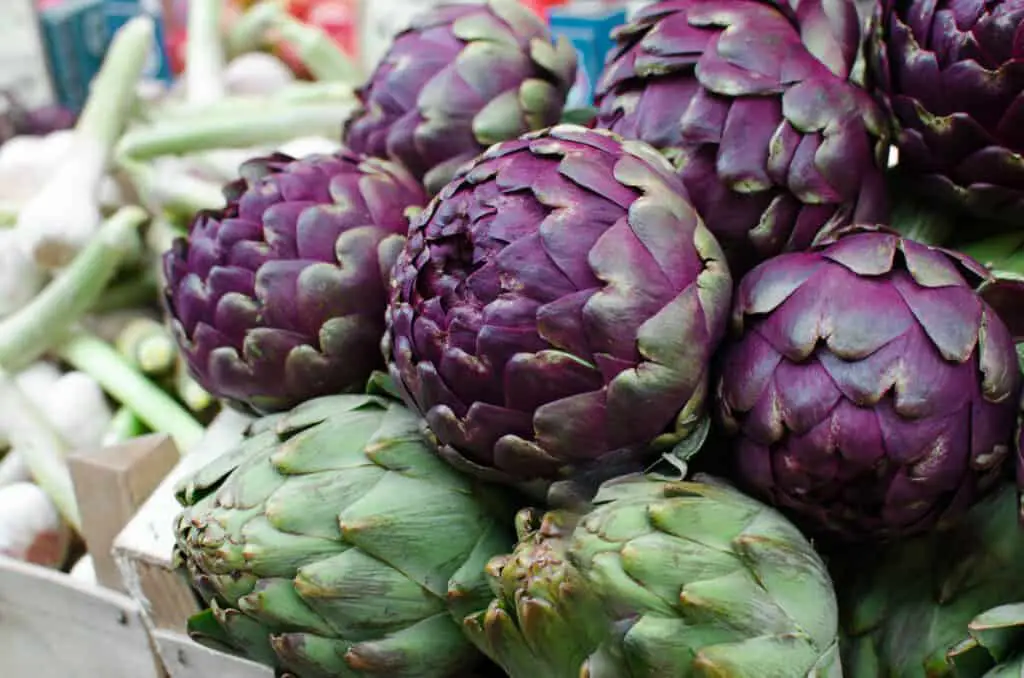This post contains affiliate links.

If you’re like me, you probably seek out any opportunity to experiment with new foods and recipes. You’re on the lookout for something novel to add to your dinner table. The artichoke could be your new favorite side. Its peculiar shape makes it exciting to try, but knowing how to prepare and eat an artichoke is key to enjoying them.
While all parts of the artichoke plant are technically edible, these are the parts you want to avoid due to the choking hazard they present: The choke, the fuzzy layer above the heart; the tough, outer layer of the petals; and the stringy, outer layer of the stem.
How do I eat an artichoke?
Eating the typical artichoke
There are many recipes for artichokes, but the most common style of the recipe is steamed artichoke with a sauce to dip the petals in.
After the artichoke has been prepared and cooked, there is a process to eating it. First, you peel off a petal and dip it in the sauce. Then you put the petal in your mouth, still holding onto the base of the petal. Since part of the petal is tough and unpleasant to eat, you’ll want to scrape off the soft, inner layer with your teeth. You can use either your bottom teeth or your top teeth for this. All of the petals can be enjoyed this way. Once all of the petals have been eaten, you’ll stumble upon the choke. The choke is a small layer of fine, fibrous hairs that proves a choking obstacle. This is the reason for the apt name, “artichoke.” This should be scooped out and discarded. It’s technically not poisonous, but anyone who has attempted to eat the choke will warn you against it. Beneath this, though, is where the tasty heart of the blossom sits. Many people enjoy this meaty surprise more than the petals themselves. This can also be dipped in sauce or eaten sans embellishment. The heart is more intense in flavor and has a much softer texture. If you choose an artichoke with a longer stem, you can also eat the inner layer of the stem with or without sauce. It has a similar flavor to the heart of the artichoke and many people like it just as well as the rest of the plant.
Other ways to eat an artichoke
While a steamed artichoke with a creamy, mustard sauce or an oily dip is scrumptious, there is a plenitude of recipes online for different styles of artichokes. Artichokes can be roasted, baked, stuffed, and even turned into dips. Because artichoke hearts are preferred by so many, you can find canned artichoke hearts at your local grocery store. Enjoying an artichoke may be a matter of finding a recipe you like. Check out this Paula Deen recipe for artichoke dip which uses canned artichoke hearts.
Do you consider yourself a cook? Experiment with your own cooking methods or make up a recipe and share it below.

There are other edible parts on the artichoke, though. The leaves, inner stem, and even the roots are edible. These aren’t commonly made into sides or main meals, but they are used in other ways and have been used for a long time. Below, I’ll describe a bit more about the medicinal uses of these parts of the artichoke.
Preparing an artichoke
Each recipe will have specific preparation instructions, but most will require the following preparation:
Rinse the artichoke with cold water.
Pull off the layer of petals closest to the stem.
Cut about half an inch off the top of the globe.
Trim the rest of the petals to remove the serrated edges.
Cut the dried, brown part of the stem where it was originally cut and score the bottom of the stem.
Because artichokes oxidize and turn brown more quickly than other produce, many people will also suggest you keep lemon juice on hand when working with them. Many recipes will have you cook them in lemon juice or rub lemon juice on them after cutting them to preserve them. In addition to lemon juice, using stainless steel cooking utensils and dishes, as opposed to aluminum or other metals, will delay the oxidation process as well.
If you aren’t using the artichokes right away, you should store them in a plastic bag in the fridge. Stored like this, they will keep for about a week, but it’s best to use them closer to the time you purchased your artichokes.
How do I choose an artichoke?
What is an artichoke?
Artichokes originated in the Mediterranean and are presently grown in southern Europe, northern Africa, a few places in South America, and in the US (mostly in California). An artichoke is an immature blossom from a thistle plant that grows atop a long stalk. Artichokes are typically considered vegetables, although they are technically thistles in the sunflower family. It takes six months for an artichoke plant to produce a blossom. When you think of an artichoke, you probably imagine something like the picture shown, a tightly packed globe of green petals. The green petals of the blossom are called bracts, although they are commonly referred to as leaves. This is how we consume artichokes, but if we allow the plant to fully blossom, the petals will open up and present the vibrant purple blossom, common to thistle plants.

You may have also heard of the Jerusalem artichoke. This is a very different species in the sunflower family that produces an edible root. Its appearance isn’t easy to mix up with the globe artichoke as it produces smaller yellow blossoms and more closely resembles a sunflower. It’s important to recognize the difference when researching globe artichokes.
Artichokes have been food for people for a long time. It’s easy to see why they are still around; they are packed with nutrients and have few calories. They also boast a nice taste when prepared correctly. Before cooking, they have a bitter taste and thick, tough meat. Cooking them softens the flavor and the texture. Many people attribute an earthy taste to artichokes, something similar to that of celery or asparagus. And, with a bit of dressing up, an artichoke can be a fabulous side or even a light, healthy snack.
Choosing an artichoke
When you are ready to experiment with some artichoke recipes, you need to know how to choose a ripe and delicious artichoke. Artichokes typically range between 3-5 inches in diameter. Many people look for larger artichokes, but the smaller ones don’t vary much in taste and can be as good an option.

Artichokes are eaten before they bloom, so you’ll want to choose an artichoke that hasn’t yet begun to bloom. Before they bloom, the bracts are firm and closed tightly. A good artichoke will seem heavy for its size and be a rich green color. Some artichokes develop little brown spots on them from frost. It’s best to avoid too many brown spots, but the spots make the artichoke taste sweeter, so some are OK. As with any produce, it’s important to check your artichokes for freshness and the stem will tell you what you need to know. The stem shouldn’t be too dried out and should seem recently cut. If you want to try eating the stem, look for a longer stem that would have enough substance to eat.
What are the health benefits of an artichoke?
Antioxidant
Artichokes are abundant with phenolic acids which are great antioxidants. We’ve all heard the word, “antioxidant,” in relation to health, but what does it really mean? When our bodies metabolize food, oxidation naturally occurs. Oxidation causes free radicals, which are basically unstable molecules that can damage our DNA. When we consume foods rich in antioxidizing nutrients, these nutrients help fight the oxidation process and save us from invasive free radicals. We need antioxidizing foods in our diets to prevent too much damage and repair the damage done already. Consuming artichokes is a fabulous way to get these antioxidants.
Other health benefits
Artichokes absorb the water in your stomach, so they often give the consumer a feeling of satisfaction and a full stomach. They are also low-calorie and packed with nutrients. Thus they are a great weight-loss tool and a great overall benefit to health. The following are some of the nutrients artichokes contain:
Vitamin C: Great for improving immune health and general health in the skin, bones, and blood vessels.
Vitamin A: Supports vision, the immune system, and the reproductive system.
Vitamin K: Improves blood and bone health.
Fiber: Most known for helping digestion, but also lowers cholesterol and helps control blood sugar.
Magnesium: Improves muscle and nerve function as well as regulates blood pressure and supports the immune system.
Sodium: Supports muscle and nerve function and helps maintain fluid balance
Iron: Is needed for growth and development and aids in the process of distributing oxygen to different parts of the body.
All of these great benefits put artichoke on the superfoods list. While being so good for you, artichokes still manage to offer an excellent taste. Adding these to your diet will improve your health and give you a great opportunity to try out new foods and recipes.
Uses as folk medicine
Because of the many nutrients artichokes possess, they have been used for ages by humans to improve health and serve as natural medicine. They even used to be more costly because of their value in aiding health. People who use artichokes have seen improvements in their health in many areas, including, the gut, liver, circulatory system, and skin health.

The most common uses of the artichoke plant relate to the digestive system. They improve your gut health by increasing the number of good bacteria. They help the liver complete its functions through detoxification. They eliminate fluid retention and boost gallbladder function.
One of the most common uses of artichoke in folk medicine was as a diuretic. A diuretic is used to combat high blood pressure by helping your kidneys excrete more salt when you urinate. Another common use is to increase bile flow from the liver. As your body receives aid in bile flow, it can cope better with things like heartburn and alcohol hangovers.
Another superpower the artichoke has is fiber. Fiber has anti-inflammatory properties and thus has been used in treating arthritis.
Medicine today
The uses of artichokes from folk medicine are valid today. Many people take artichoke supplements to promote better health and overcoming their specific ailments. Today, you can buy artichoke capsules at your local health food store or online. Many people affirm the benefits and recommend them to anyone looking to improve overall health. There are countless websites that will tell you all about the superfood properties of artichokes.
We definitely recommend artichokes! They are healthy and tasty. What more could you want?


